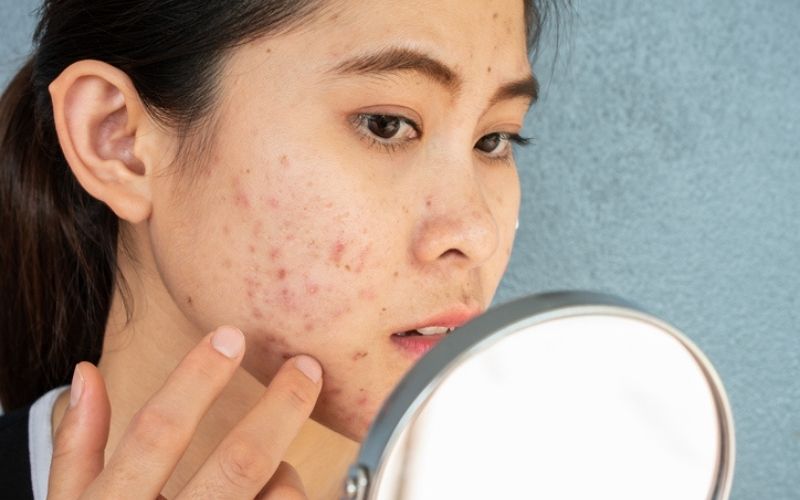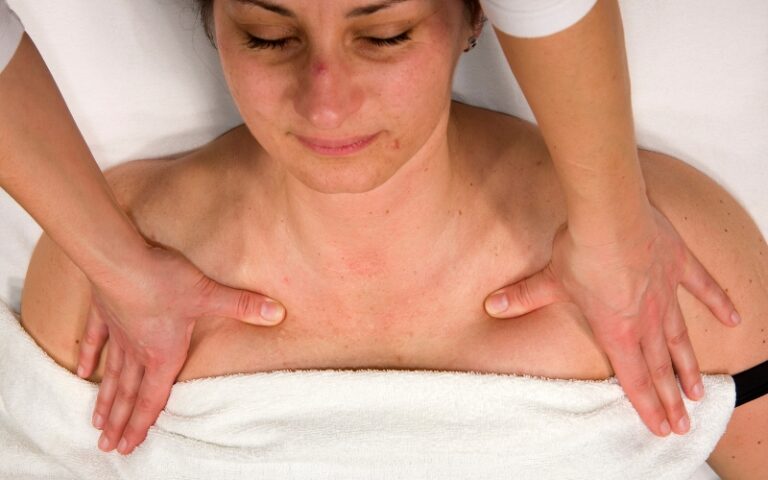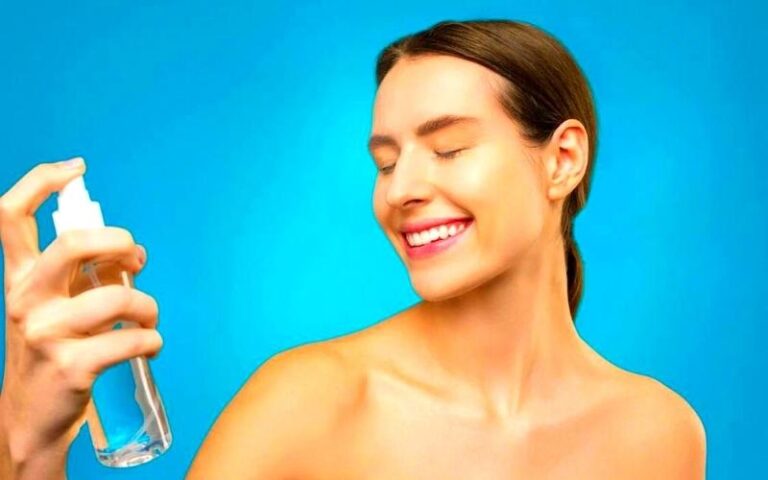Fungal Acne vs Closed Comedones: Major Differences

When it comes to fungal acne vs closed comedones, it’s important to understand that not all acne is the same. There are different types of acne that plague us, such as the kind of acne caused by fungus and acne caused by skin debris and bacteria.
At first glance, the tiny bumps appear the same; however, with careful study, each condition differs in their presentation and treatment. It’s important to recognize the differences in these little bumps so you can diagnose which type you have in order to treat it properly and to eradicate it quickly and effectively.
Just remember, these conditions can affect you at any stage of your life, not just your teen years.
The Difference Between Fungal Acne vs Closed Comedones
While they may seem similar, the main difference between fungal acne vs closed comedones lies in both the causes and the treatments.
Since fungal acne is caused by fungus, it requires treatments that reduce the amount of fungus in the skin microbiome.
Comedonal acne is caused by bacteria, excess oil, and clogged pores which requires treatments that kill acne bacteria as well as keep pores clear.
Read more to learn about both and figure out which one you’re dealing with!
What Is Fungal Acne?
Fungal acne is not truly acne.
It is actually an overgrowth of a certain type of yeast/fungi, called Malassezia(malassezia yeast), in your hair follicles leading to a condition known as pityrosporum folliculitis or Malassezia folliculitis (1).
This yeast is a normal inhabitant of the skin, but in the case of fungal acne, there is an overgrowth of this yeast on the skin’s surface and in the follicles that causes tiny bumps to form.
The yeast feeds off of the oil (sebum) in our skin.
Symptoms Of Fungal Acne
Signs of fungal acne worth noting are that it presents as monomorphic (same size) small red bumps (papules) or pus filled bumps (pustules) that present in small clusters on the skin’s surface and are often accompanied by itching.
These pimple-like bumps appear in oily areas of the body, such as the T zone (forehead, nose, and chin) and jawline of the face, chest, and back. Oftentimes, these small red bumps look almost like traditional acne or milia which can make their diagnosis tricky.
Pityrosporum folliculitis may also appear in conjunction with other fungal infections and yeast causing conditions, such as dandruff or seborrheic dermatitis (2).
If you think you have fungal acne, we have a full, in-depth guide on how to get rid of it here.
How Do I Treat Fungal Acne?
Fungal acne cannot be treated with the same products that you treat traditional acne, because it is caused by different organisms.
It is an infection of the hair follicles caused by a fungus, not a bacteria. Since fungal acne is caused by a yeast/fungi, you should treat it with an antifungal medication, such as topical antifungal creams, like ketoconazole, or oral antifungal medicines, like fluconazole, to eradicate the problem.
As with acne in the big picture, you should not try to pop the red bumps of fungal acne. This can lead to worsening of the lesion, infection and scarring.
How Do I Prevent Fungal Acne?
Once you have treated your fungal acne, you want to make sure it does not recur.
Since it is caused by an overgrowth of yeast and this yeast feeds off of your oil (sebum), you want to avoid things that can upset the balance in your skin and lead to a recurrent fungal infection (3).
- Avoid tight clothing that can trap heat by restricting airflow which will lead to yeast/fungi overgrowth. Yeast loves warm places to grow. Wear loose breathable fabrics. Heat and sweat play a big part in the recurrence of this condition.
- Shower frequently if you have a job that makes you sweat a lot or you live in a humid climate or you are outside during the warm time of the year. Yeast love wet places to grow, so keep excess moisture away from your skin.
- Avoid eating excess carbohydrates because yeast thrive on sugars.
- Use a dandruff shampoo (pyrithione zinc or selenium sulfide that contains keratin) weekly as a face and body wash to prevent yeast overgrowth in the location you’re experiencing a breakout. Leave it on for multiple minutes to let the ingredients get absorbed by your skin.
What Is Comedonal Acne?
Traditional or true acne is a skin condition caused by dirt, oil and bacteria that clog your pores. Pores are tiny openings on the skin’s surface that lead downward to your hair follicles. Your hair grows up from the hair follicles and out through our pores. Oil glands are attached to the pores and allow oil secretion to the surface of the skin.
When dirt, oil and dead skin cells get trapped in your pores, this creates comedonal acne (4). If the pore is open, you will develop blackheads (open comedones). Interestingly, the black color of these blackheads is caused by oxidation of the debris and sebum when it is exposed to air.
If the pore is closed, you will develop pustules (whiteheads or closed comedones or closed comedo). The pus, which is caused by trapped bacteria and white blood cells, gives whiteheads their white color.
When bacteria gets trapped in the pores, this leads to inflammatory acne which appears as small red bumps (papules), large bumps (nodules) or cysts (blind pimples).
Inflammatory acne can be more difficult to treat and even cause symptoms such as pain.
Comedonal Acne Symptoms
Closed comedones are small, flesh-toned, non-itchy bumps that predominantly occur on the face.
Breakouts will present haphazardly in oily locations on the face and body, like the chest, upper arms and back, but not in clusters as seen in cases of fungal acne. They are usually not accompanied by symptoms of itching, which is found in cases of fungal acne.
Also, clinical acne lesions can appear in different sizes and types in the same patient, which helps you distinguish it from fungal acne. Very similar looking skin bumps gives the fungal acne look.
If you want to know more, we have an ultimate guide to getting rid of closed comedones.
How Do I Treat Comedonal Acne?
There are a variety of treatment options that can lessen your breakouts, both over the counter treatments (OTC) and prescription. Treatment is geared towards the acne type you have.
Combination therapy, including topical treatments and oral ones, may give the best results in more extensive cases. Oral medications are usually reserved for inflammatory acne.
Comedonal acne treatments often involve ingredients like:
- Benzoyl peroxide – Benzoyl peroxide (BP) helps kill bacteria and cause exfoliation of dead skin cells to eradicate comedones. It may bleach the skin , so you may need to avoid its use in darker skin types. It can be used as a face and/or body wash.
- Salicylic acid – Salicylic acid (SA) is a beta hydroxy acid (BHA) that helps exfoliate dead skin cells as well to treat comedones. SA also has anti-inflammatory properties to help combat redness and swelling in mild cases of inflammatory acne. It can also be used as a face and/or body wash.
- Topical retinoids – Topical retinoids work well at exfoliating dead skin cells too, stopping excess oil production, and also helping fade brown spots that can appear after the pimple has resolved. Retinoids can also treat some types of acne scars.
- Topical antibiotics – Prescription topical antibiotics, such as erythromycin and clindamycin, work well at killing the bacteria that cause acne, P. acnes. Oftentimes, they are combined with BP, which leads to better results and prevents bacterial resistance to the antibiotic agents that can occur when antibotics are used alone.
- Oral antibiotics – Oral antibiotics, such as doxycycline and minocycline, work by not only killing bacteria causing acne, but also by reducing the inflammation associated with certain types of acne. If they cannot be tolerated, oral erythromycin or azithromycin has been used with some success.
- Azelaic acid – Topical azelaic acid helps get rid of dead skin cells and unclog pores. It also has anti-bacterial and anti-inflammatory properties. It should not be used in darker skin types as it can bleach the skin. This can often be found in certain azelaic acid serums, for example, The Ordinary azelaic acid serum.
- Glycolic acid – Glycolic acid is an alpha hydroxy acid (AHA) that helps exfoliate dead skin cells to help with acne breakouts. It also helps fade dark spots and lessen wrinkles.
- Anti-androgens – Certain oral medications, such as spironolactone, work to decrease androgen production, which are hormones responsible for excess sebum production that leads to acne (6).
- Birth control pills – Certain birth control pills have also been used to treat acne because they decrease androgens, which cause breakouts.
- Isotretinoin – Isotretinoin is an oral form of retinoids, which is reserved for only the most severe cases of acne because of its long list of transient side effects, such as dry skin/lips/eyes, depression, and joint pain; significant permanent long term problems, such as inflammatory bowel disease; and development of birth defects if taken while pregnant. This oral acne treatment works the same way as topical retinoids to treat acne, but it is just more potent and effective.
- Dapsone – Topical dapsone works to resolve acne breakouts by acting as an anti-inflammatory agent.
- Chemical peels or exfoliants – Chemical peels or exfoliants, that contain chemical exfoliators such as retinoids, salicylic acid and glycolic acid, work by removing dead skin cells, dirt and oil that clog pores. Chemical exfoliators are usually safer for novices than physical exfoliators.
How Do I Prevent Acne?
Prevention is just as important as treatment for regular acne. If you don’t take proper care of your skin, no treatment will help get rid of blemishes.
Here are some different things you can do to keep your skin healthy.
- Cleanse – It is important to cleanse twice a day to remove dirt, oil and bacteria from the skin to prevent new acne from forming. You must also wash immediately after working out or sports.
- Oil free products – It is important to use only non-comedogenic oil free skincare products to avoid clogging your pores and causing more breakouts. This includes soap, moisturizer, sunscreen, makeup and hair products. You must check the ingredients before you use any product on your skin.
- Moisturize – It sounds counterintuitive, but patients with oily acne-prone skin need to moisturize twice daily after cleansing to avoid skin dehydration. If you don’t, your body will think it is dry and end up increasing sebum production which will cause more blemishes.
- Healthy diet – It is important to avoid carbohydrates which lead to more breakouts. Even dairy can worsen acne in some cases (5).
- Proper hygiene – Make sure all things that come into contact with your face are cleansed daily such as pillowcases, towels, washcloths, face masks, athletic equipment and cellphones. These things can harbor dirt and bacteria, which lead to more pimples. It is important to keep your hair clean, because greasy dirty hair that lays on your face will increase your chances of more breakouts. Clean your razors daily with alcohol and change them frequently. Also, do not pop pimples, as this can lead to worsening of the acne, infection and scarring. People think it will make acne go away quicker, but it will make it last longer. Also, getting regular facials by an esthetician can help keep your pores clean.
- Exfoliation – Exfoliating regularly helps in removing dead skin cells, preventing blockage of hair follicles. Thus, it can also help prevent acne formation.
Conclusion: Closed Comedones vs Fungal Acne
While Fungal Acne and Closed Comedones can both be distressing, recognizing their distinctions is the first step in seeking the most appropriate treatment.
If you have been suffering for a long time and have not been able to get your fungal acne or regular inflammatory or comedonal acne under control and you have exhausted all OTC products, don’t give up.
The good news is your dermatologist can help you understand the difference between fungal acne vs closed comedones and get you on the right treatment plan. You should seek evaluation and treatment by a board certified dermatologist, who can help you before you have permanent scarring.
Armed with knowledge and the right skincare approach, both conditions can be effectively managed, paving the way for clearer, healthier skin.
Acne is not just a teenager problem; it affects all ages.
FAQs
Q: Do I have fungal acne or closed comedones?
A: Understanding the difference between fungal acne and closed comedones is crucial for appropriate treatment. While both appear as small bumps on the skin, fungal acne is induced by an overgrowth of yeast and can often be itchy, especially when found as mild fungal forehead acne. Closed comedones, often referred to as closed pimples or blocked comedones, arise from hair follicles clogged by sebum and dead skin cells.
Q: Can closed comedones be itchy?
A: Typically, closed comedones aren’t itchy. If you’re experiencing itchiness with small bumps on the skin, it might indicate fungal acne or another skin condition. However, external factors like harsh skincare products can sometimes cause irritation and itchiness around closed comedones.
Q: What causes skin congestion leading to closed comedones?
A: Skin congestion for closed comedones usually stems from accumulated sebum, dead skin cells, and sometimes makeup residues that block hair follicles. Factors such as hormonal fluctuations, certain medications, and the use of comedogenic products can exacerbate the problem.
Q: Are closed pimples the same as closed comedones?
A: Yes, closed pimples is another term commonly used for closed comedones. They are characterized by their small, flesh-toned appearance, often appearing as bumps under the skin without a visible “head.”
Q: What are blocked comedones, and how do they differ from open ones?
A: Blocked comedones, also known as closed comedones or whiteheads, are hair follicles blocked with sebum and dead skin cells but covered with a layer of skin. This differentiates them from open comedones (blackheads), where the blocked follicle remains open, and the surface oxidizes, turning black.
Q: Can you explain what closed blackheads are?
A: Closed blackheads is a term that can be misleading. Blackheads are typically open comedones where the blocked sebum oxidizes and turns black. When people refer to “closed blackheads,” they usually mean closed comedones or whiteheads, which are covered by a thin layer of skin and don’t turn black.
Q: What are the primary causes of closed comedones?
A: Closed comedones cause sebum buildup and dead skin cells within the hair follicle. Hormonal changes, certain medications, comedogenic skin care products, and lack of regular exfoliation can contribute to their formation.
Q: Are fungal bumps on the face always an indication of fungal acne?
A: Not always. While fungal bumps on the face can indicate fungal acne, other conditions like folliculitis, allergic reactions, or even regular acne can manifest as bumps on the face. Getting a proper diagnosis from a dermatologist for accurate treatment is essential.
Sources
1. Rubenstein RM, Malerich SA. Malassezia (pityrosporum) folliculitis. J Clin Aesthet Dermatol. 2014 Mar;7(3):37-41. PMID: 24688625; PMCID: PMC3970831. Closed comedones vs fungal acne
2. Prohic A, Jovovic Sadikovic T, Krupalija-Fazlic M, Kuskunovic-Vlahovljak S. Malassezia species in healthy skin and in dermatological conditions. Int J Dermatol. 2016 May;55(5):494-504. doi: 10.1111/ijd.13116. Epub 2015 Dec 29. PMID: 26710919. fungal acne vs closed comedones
3. Vlachos C, Henning MAS, Gaitanis G, Faergemann J, Saunte DM. Critical synthesis of available data in Malassezia folliculitis and a systematic review of treatments. J Eur Acad Dermatol Venereol. 2020 Aug;34(8):1672-1683. doi: 10.1111/jdv.16253. Epub 2020 Apr 30. PMID: 32012377.
4. Zaenglein AL, et al. Guidelines of care for the management of acne vulgaris. J Am Acad Dermatol. 2016; 74: 945-73.
5. American Academy of Dermatology website www. AAD.org
6. Smith RN, Mann NJ, Braue A, Makelainen H, Varigos GA. The effect of a high-protein, low glycemic-load diet versus a conventional, high glycemic-load diet on biochemical parameters associated with acne vulgaris: a randomized, investigator-masked, controlled trial. J Am Acad Dermatol. 2007;57:247-256.





